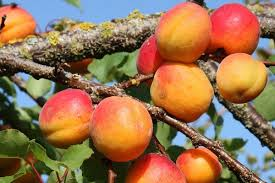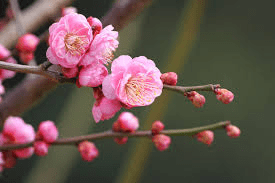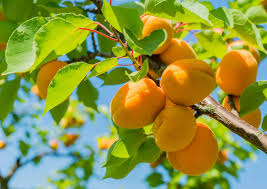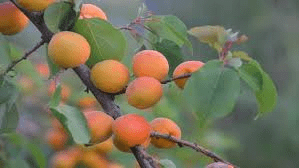Apricot pedicels are the individual, slender stalks that attach each flower or fruit to the main peduncle of the apricot tree (Prunus armeniaca). They play a critical role in connecting the flowers and fruits to the branch, facilitating the transport of nutrients and supporting the structures as they develop.
Structurally, pedicels are relatively thin and flexible, allowing them to hold flowers and fruits in place while providing some movement. This flexibility helps the apricot flowers and fruits absorb sunlight and exposure to pollinators more effectively. The pedicels are typically green and smooth, becoming more rigid as they mature.
During the flowering phase, each flower is attached to the branch by its own pedicel. The length and strength of the pedicel can influence the positioning of the flower, affecting its accessibility to pollinators. Flowers with longer pedicels are often spaced out more, which can help prevent overcrowding and improve pollination efficiency. The pedicels ensure that the flowers are well-positioned for pollinators to transfer pollen from one flower to another, enabling successful fertilization.
After pollination, the pedicels continue to support the developing fruit. As the apricot fruit grows, the pedicel must support the weight of the fruit and maintain its connection to the peduncle. The pedicel’s ability to transport nutrients and water from the tree to the fruit is crucial for proper fruit development and ripening.
Healthy pedicels are essential for good fruit production. Any damage or stress to the pedicels can negatively impact flower or fruit development. For example, diseases such as fungal infections or bacterial canker can weaken the pedicels, leading to issues such as poor fruit set, fruit drop, or reduced fruit quality. Additionally, physical damage from pests or adverse weather conditions can affect the pedicels’ functionality.
Horticultural practices can help ensure the health and effectiveness of the pedicels. Regular inspection of the tree can help identify any signs of disease or damage early, allowing for timely intervention. Proper watering, fertilization, and pest management are also important for maintaining the health of the pedicels and the overall tree.
Aapricot pedicels are the slender stalks that connect each flower or fruit to the main peduncle. They play a vital role in supporting the flowers and fruits, facilitating nutrient transport, and aiding in pollination. Proper care and management of the pedicels are crucial for ensuring healthy flower and fruit development and overall tree productivity.
The Economic Importance and Uses of Apricot Pedicels

1. Horticultural Uses: Apricot pedicels support fruit development by connecting the fruit to the stem. They are essential for the health and stability of the apricot fruit during growth.
2. Crafting Material: Dried apricot pedicels are used in crafting projects, including making decorative arrangements and natural art pieces.
3. Mulch: Shredded apricot pedicels can be used as mulch in gardens to help retain soil moisture, suppress weeds, and improve soil quality.
4. Composting: Apricot pedicels can be added to compost piles as organic material, contributing to the nutrient content and helping in the decomposition process.
5. Biomass Fuel: Dried apricot pedicels can be used as biomass fuel, providing a renewable energy source for heating and power generation.
6. Soil Erosion Control: Pedicels can be used to create barriers or cover on slopes to prevent soil erosion and stabilize soil.
7. Animal Bedding: Chopped pedicels can be used as bedding material for livestock, providing a comfortable and absorbent surface.
8. Potpourri: Dried apricot pedicels are used in potpourri mixtures, adding texture and a natural element to home décor and air freshening products.
9. Natural Fencing: Sturdy pedicels can be used in constructing natural fences or garden trellises, offering an eco-friendly and durable fencing option.
10. Educational Uses: Pedicels are used in educational settings to teach students about plant anatomy and the role of pedicels in fruit development.
11. Decorative Art: Pedicels can be used in various forms of decorative art, such as making botanical prints or creating natural sculptures.
12. Seedling Pots: Pedicels can be used to create biodegradable pots for seedlings, providing an eco-friendly option for starting plants.
13. Eco-Friendly Packaging: Pedicels can be used in sustainable packaging materials, such as biodegradable fillers and cushioning for packaging.
14. Soil Improvement: Chopped pedicels can be mixed into soil to improve its structure and drainage, enhancing plant growth.
15. Herbal Infusions: Pedicels are sometimes used in herbal infusions or teas, believed to have mild health benefits.
16. Craft Supplies: Pedicels are used as part of craft supplies for making wreaths, garlands, and other handmade items.
17. Wildlife Habitat: Decaying pedicels provide habitat and food sources for various wildlife, contributing to biodiversity in natural settings.
18. Livelihood: Harvesting and selling apricot pedicels can provide income for local communities, supporting economic development through the sale of floral and gardening products.
Read Also: Pixie Bob Cat Breed Description and Complete Care Guide
The Products and By-products That Can Be Derived From Apricot Pedicels

1. Mulch: Shredded apricot pedicels are used as mulch in gardening to help retain soil moisture, suppress weeds, and improve soil quality.
2. Compost: Apricot pedicels are added to compost piles as a source of organic matter, enriching the compost with nutrients.
3. Biomass Fuel: Dried pedicels are used as biomass fuel, providing a renewable energy source for heating and power generation.
4. Soil Erosion Barriers: Pedicels are used to create barriers on slopes to control soil erosion and stabilize the soil.
5. Animal Bedding: Chopped pedicels are used as bedding for livestock, offering a comfortable and absorbent surface.
6. Potpourri: Dried pedicels are included in potpourri mixtures, adding texture and a natural element to the blend.
7. Natural Fencing: Pedicels can be used to construct natural fences or garden trellises, providing an eco-friendly and durable option.
8. Educational Tools: Pedicels are used in educational settings to teach about plant anatomy and the role of pedicels in fruit development.
9. Decorative Art: Pedicels are used in making botanical prints, sculptures, and other decorative art pieces.
10. Seedling Pots: Pedicels can be used to create biodegradable pots for seedlings, offering an eco-friendly planting option.
11. Packaging Materials: Pedicels are used in sustainable packaging as biodegradable fillers and cushioning materials.
12. Soil Improvement: Chopped pedicels are mixed into soil to enhance its structure and drainage, supporting better plant growth.
13. Herbal Infusions: Pedicels are used in herbal teas and infusions, providing mild health benefits and a unique flavor.
14. Craft Supplies: Pedicels are used in various craft projects, such as making garlands, wreaths, and other handmade items.
15. Wildlife Habitat: Decaying pedicels provide habitat and food for wildlife, contributing to ecological balance.
16. Livelihood: Harvesting and selling apricot pedicels can provide income for local communities, supporting economic development.
17. Plant Research: Pedicels are studied in plant research to understand their role in fruit development and plant physiology.
Read Also: How Much Does It Cost to Adopt a Pet
Frequently Asked Questions (FAQ’s) About Apricot Pedicels

1. What are the main uses of apricot pedicels in gardening?
Apricot pedicels are primarily used to support fruit development by connecting the fruit to the stem. They are also used in gardening as mulch or compost, which helps improve soil quality.
2. Can apricot pedicels be used in crafts?
Yes, dried apricot pedicels are used in crafting projects, including making decorative arrangements, wreaths, and other natural art pieces.
3. How are apricot pedicels used as mulch?
Shredded apricot pedicels are spread around plants to act as mulch. They help retain soil moisture, suppress weeds, and enrich the soil.
4. Are apricot pedicels used as fuel?
Yes, dried apricot pedicels can be used as biomass fuel. They are burned to generate heat and energy in various applications.
5. How do apricot pedicels help with soil erosion control?
Pedicels can be used to create barriers on slopes, which helps control soil erosion and stabilize the soil by reducing runoff and preventing soil loss.
6. Can apricot pedicels be used in animal bedding?
Yes, chopped apricot pedicels are used as bedding material for livestock. They provide a comfortable and absorbent surface.
7. What is potpourri made from apricot pedicels?
Potpourri made from apricot pedicels includes dried pedicels mixed with other aromatic materials. They add texture and a natural element to the mixture.
8. How are apricot pedicels used in educational settings?
Pedicels are used in educational settings to teach students about plant anatomy, reproduction, and the role of pedicels in fruit development.
9. Can apricot pedicels be used in eco-friendly packaging?
Yes, apricot pedicels can be used as sustainable packaging materials, such as biodegradable fillers and cushioning, reducing environmental impact.
10. How do apricot pedicels contribute to wildlife habitats?
Decaying pedicels provide habitat and food for various wildlife, contributing to biodiversity and ecological balance in natural settings.
Read Also: Complete Composting Guide for Beginners

